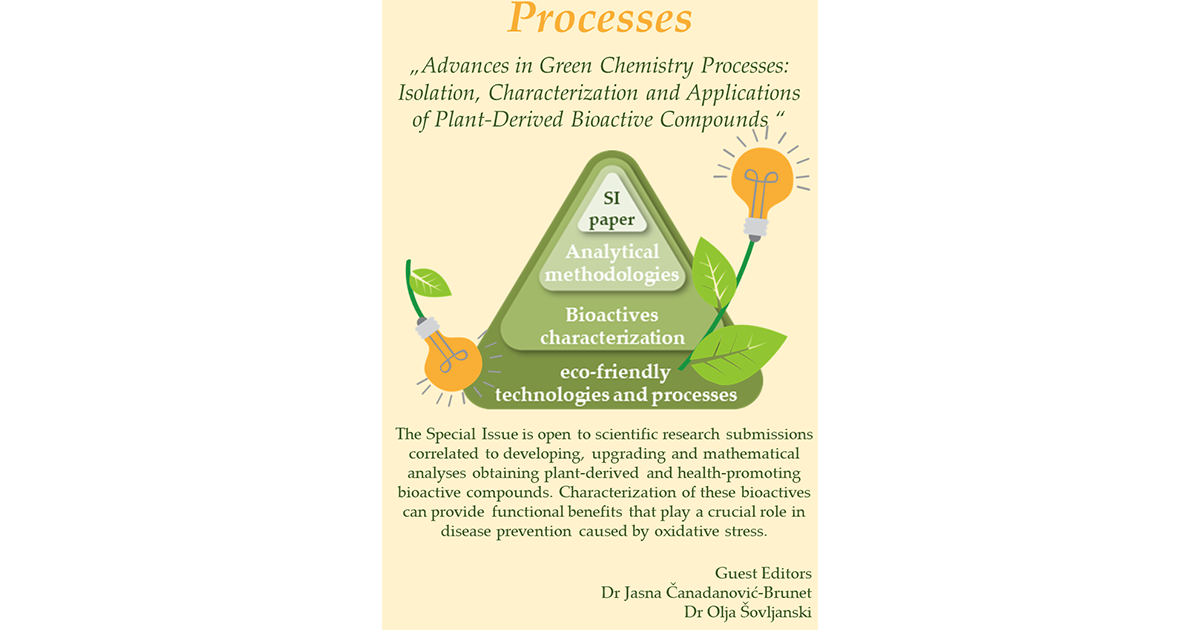- 2.8Impact Factor
- 5.5CiteScore
- 16 daysTime to First Decision
Advances in Green Chemistry Processes: Isolation, Characterization and Applications of Plant-Derived Bioactive Compounds
Special Issue Information
Dear Colleagues,
Growing public and consumer demand, accompanied by ongoing research efforts to investigate the qualities and prospective applications of nutraceutical substances, have led to an increased interest in processes related to bioactive compounds, phytochemicals, and functional foods. The transparent diversity of natural product chemistry's sources reveals its beauty. Also the processing of plants results in high amounts of bio-wastes (by-products) which causes economic and ecological deficit problems. Today, the biowastes are often utilized as feed, and for the preparation of dietary fibre and biofuel through bioconversation processes. These products are also promising sources of bioactive antioxidants and colour-giving compounds, which could be used in food, pharmaceutical and cosmetic industries. To isolate, identify, and use bioactive chemicals from natural sources, extraction and conversation processes are an important phase along with the screening of their bioactivities and ultimately the elucidation of structure–activity relationships. In this context, the current Special Issue is open to scientific research submissions correlated to developing, upgrading and mathematical analyses obtaining plant-derived and health-promoting bioactive compounds. Characterization of these bioactives can provide functional benefits that play a crucial role in disease prevention caused by oxidative stress. A special emphasis will be given to eco-friendly technologies and processes with a deep insight into bioactivities characterization using analytical methodologies, in vitro assays, as well as in silico and in vivo studies to evaluate pro-healthy effects, including anti-inflammatory, antimicrobial, antioxidant properties and application safety, addressing potential final applications.
Potential topics include but are not limited to the following:
- Extraction, preservation, and identification/quantification of plant-derived bioactives
- New findings on the structure, functionality, nutrition, and application of natural products.
- New trends in the application of eco-friendly techniques to extract bioactive compounds.
- Isolation and characterization of nutritional components from plant extracts
- Characterization of extracts and their possible uses.
- Methods to improve the bioaccessibility and bioavailability of the targeted compounds.
- Methods to explore the antioxidant and anti-inflammatory activity of bioactive compounds in food
- Antimicrobial effects of bioactive components derived from food, and their interaction with gut microbiome and their health outcomes
- Antidiabetic and antiobesity effects of bioactive compounds
- In vitro and in vivo evaluation of the function of plant-derived bioactives
- Food bioactive components and their functionalities in health problems.
Prof. Dr. Jasna Čanadanović-Brunet
Dr. Olja Lj. Šovljanski
Guest Editors
Manuscript Submission Information
Manuscripts should be submitted online at www.mdpi.com by registering and logging in to this website. Once you are registered, click here to go to the submission form. Manuscripts can be submitted until the deadline. All submissions that pass pre-check are peer-reviewed. Accepted papers will be published continuously in the journal (as soon as accepted) and will be listed together on the special issue website. Research articles, review articles as well as short communications are invited. For planned papers, a title and short abstract (about 100 words) can be sent to the Editorial Office for announcement on this website.
Submitted manuscripts should not have been published previously, nor be under consideration for publication elsewhere (except conference proceedings papers). All manuscripts are thoroughly refereed through a single-blind peer-review process. A guide for authors and other relevant information for submission of manuscripts is available on the Instructions for Authors page. Processes is an international peer-reviewed open access monthly journal published by MDPI.
Please visit the Instructions for Authors page before submitting a manuscript. The Article Processing Charge (APC) for publication in this open access journal is 2400 CHF (Swiss Francs). Submitted papers should be well formatted and use good English. Authors may use MDPI's English editing service prior to publication or during author revisions.
Keywords
- secondary metabolites
- bioactive compounds
- characterization of bioactive compounds
- innovative food
- plant natural resources
- by-products
- antioxidants
- green extraction
- chromatography
- health benefits
- bioactivity
- bioavaiability

Benefits of Publishing in a Special Issue
- Ease of navigation: Grouping papers by topic helps scholars navigate broad scope journals more efficiently.
- Greater discoverability: Special Issues support the reach and impact of scientific research. Articles in Special Issues are more discoverable and cited more frequently.
- Expansion of research network: Special Issues facilitate connections among authors, fostering scientific collaborations.
- External promotion: Articles in Special Issues are often promoted through the journal's social media, increasing their visibility.
- e-Book format: Special Issues with more than 10 articles can be published as dedicated e-books, ensuring wide and rapid dissemination.

